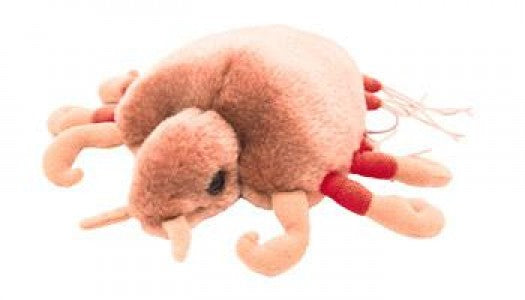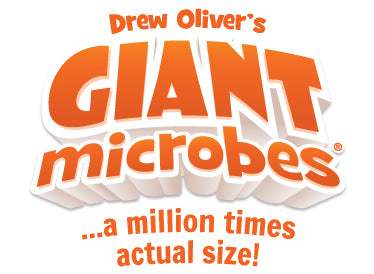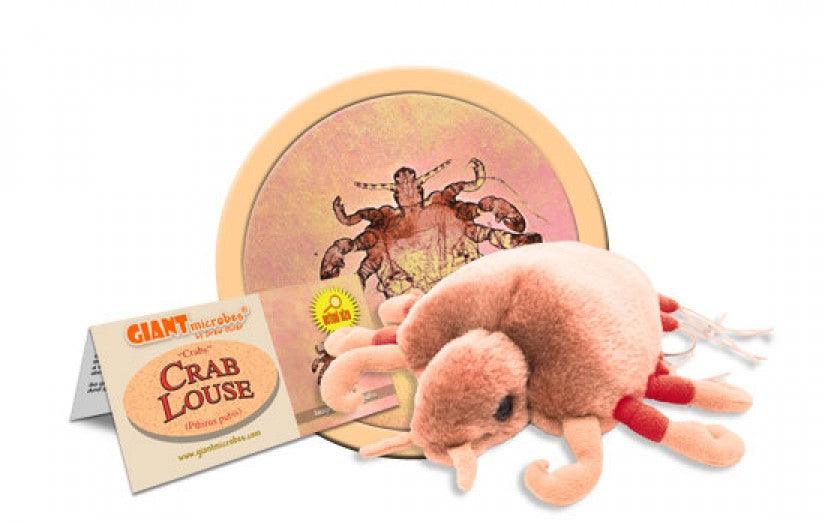Crab Louse (Pthirus Pubis)
Crab Louse (Pthirus Pubis)
Couldn't load pickup availability
- A useful tool for sex education classes
- An unforgettable gag gift
All About Crab Louse (Pthirus Pubis)
FACTS: Crab lice, or Pthirus pubis, are tiny "crabs" less than 2 mm long. They can easily go unnoticed, but eventually make their presence felt by intense itching, the result of hypersensitivity to their saliva as they feed on their unfortunate host's blood.
Crab lice get their appellation from their general appearance: they possess a more or less crab-shaped body and large claws, albeit on their hind legs, with which they cling to hair. Though they favor their namesake genital habitat, they may also migrate to other regions endowed with coarse hair, such as the limbs, underarms, beard, mustache, and even eyelashes.
Unlike their “body louse” cousins, crabs are not considered to be a major health hazard, as they are not a significant vector for any disease, though that is little consolation to their hosts.
However, treatment is generally straightforward: a number of creams and shampoos containing pyrethrins or other insecticides are commercially available which effectively terminate crabs. (Unfortunately, their death grip is generally powerful enough that it may still be necessary to remove them manually.)
Although crab lice generally disperse through intimate contact, it is in fact possible to catch crab lice from clothing, bedding, or towels, as they can live for several days away from the human body. Washing clothing and bedding in a hot laundry cycle followed by a hot tumble dry – and staying clean – can prevent crab lice from clawing their way into your life.
NAME Crabs are actually parasitic pubic lice, called Pthirus pubis. Don’t confuse this critter’s name for a magic spell! ‘Pthirus’ is the Greek root word for louse and ‘pubis’, as you may have guessed, is describes the pubic region. This insect is better known as “Crabs” because it actually looks like a tiny, microscopic crab!
ACTUAL SIZE It’s about 2 millimeters, which is twice the size of a single grain of salt!
WHERE IT LIVES These pesky critters can spread directly by skin contact with pubic areas or indirectly from infested objects. This means they can spread by sleeping in an infested bed, wearing infested clothes, or even using an infested towel!
SYMPTOMS The single most characteristic symptom of this disease is severe itching. Like head lice, when these pests bite down on your skin, their saliva causes an allergic reaction that triggers the itching. Although they’re most commonly found hanging onto pubic hairs, they can sometimes find their way to other hairy regions of the body.
CURE Insecticide ointment, cream, lotion, and shampoo are the recommended treatment, depending on where the infestation is located.
HISTORY Scientists have found archaeological evidence that crabs have been around for thousands of years. They’ve been found on mummified human remains from South America and Medieval Britain.
Outbreaks: Since this disease more of a nuisance than a public health concern, the U.S. Center for Disease Prevention and Control (CDC), and the World Health Organization (WHO) don’t collect incidence data on crabs.
FASCINATING FACTS DNA evidence revealed that human crabs evolved from gorilla crabs 3.3 million years ago when the human ancestor, Australopithecus, evolved. The famous “Lucy” fossil came from this era.
Famous people who died of it: As uncomfortable as this disease may be, people don’t die from crabs. Tremaine Neverson, the American singer, songwriter, and rapper better known as Trey Songz, admitted that one of his ex-girlfriends gave him crabs when he was 16.




